Croatian Companies Generally Optimistic About Customer Payment Discipline
November the 22nd, 2022 - The European Union (EU) average when it comes to companies being placed in serious jeopardy because of poor financial discipline is higher than the Croatian one, but that doesn't mean that Croatian companies aren't also finding themselves in hot water more often than they should.
As Poslovni Dnevnik/Suzana Varosanec writes, almost two out of three companies operating within the European Union (EU) believe that customer payment discipline will worsen in the coming period, according to the thirteenth representative EOS survey entitled "European payment habits", in which 3,200 companies spanning sixteen different European countries, including those operating here in the Republic of Croatia, were examined.
When it comes to Croatian companies, however, things are (quite surprisingly) a little bit more optimistic than the European Union average; namely, only one in three out of four Croatian companies currently predicts a worsening of payment discipline, and as they state, a quarter of them even believe that it will improve. In comparison, back in the very successful pre-pandemic year of 2019, every other company operating in this country held the opinion that improvement was around the corner.
"Although it's less than the European Union average, the fact is that as of 2019, almost twice as many Croatian companies, based on experience, estimate the deterioration of their payment habits, while there are also significantly fewer who believe that they will improve. This is a clear indicator of future trends, given the current economic figures and high inflation," said Barbara Cerinski, the director of EOS Matrix.
Otherwise, payment habits across Europe have worsened quite significantly over the last three years, as was confirmed by this research, which points out that the above-mentioned development is causing approximately one in five companies to suffer legitimate fears for their own existence.
For more on Croatian companies, startups and entrepreneurs, make sure to keep up with our dedicated business section.
Share of Croatian Women Listed as Company Founders Increased in 2021
November the 22nd, 2022 - The share of Croatian women who started their own businesses last year is incredibly encouraging, with the number of companies with women at the helm on the up.
As Poslovni Dnevnik/Suzana Varosanec writes, last year, a group which is made up of 47,041 enterprises had at least one woman on the Management Board or Supervisory Board. Croatian women held 95,777 functions, of which 51,535 were management functions, while in 1,846 cases women held supervisory functions (members of the Supervisory Board), and in 42,396 cases - they appeared as company founders. The above was shown in Fina's recent analysis that looked into the results of the aforementioned group's operations according to GFI data for the years 2019-2021.
"Back in 2021, the observed group of enterprises held capital in the amount of 161.6 billion kuna and had total assets in the amount of 752.5 billion kuna. Compared to 2019, the number of companies in the observed group increased by 12.2%, their total income increased by 11.7%, their total expenses by 11.0%, their profit for that period by 23.5%, their losses for that period by 14.0%, while the number of employees decreased by 0.6% in 2021," stated Fina's analysis, and as we know, Fina itself is strongly represented with a high proportion of women employed in managerial positions.
Out of a total of 291 employees working in management positions within Fina (management, director of sectors and other organisational units), 210 were Croatian women, which makes up a share of 72%.
According to the data from the processed GFI for the year 2021, 473,821 employees were employed in this group, and those companies achieved 471.5 billion kuna in total revenue, a period profit of 31.4 billion kuna, a loss of 6.9 billion kuna, and an impressive net profit in the amount of 24.4 billion kuna kuna.
The largest total revenues (73.0%), profit for the period (69.6%), and loss for the period (75.8%) were achieved by limited liability companies. In second place came joint-stock companies with a share in total revenues of 22.9%.
The largest number of enterprises of this group operated in the City of Zagreb (34.8%) and Split-Dalmatia County (10.3%). Companies of this group in the City of Zagreb employed 44.4% of the total employees and achieved 53.9% of total income, 57.4% of profit for the period and 53.3% of loss for the period. Analysis by activity shows that the largest number of enterprises within this group operated in professional, scientific and technical activities (20.7%) and wholesale and retail trade (19.8%). The largest number of employees was in the processing industry (25.0%) and wholesale and retail trade (19.3%). The largest total income was achieved by companies from wholesale and retail trade (29.8%), and the highest profit of the period was achieved within the processing industry (26.7%).
"The largest number of companies of this group (73.3%) operated in the form of limited liability companies (d.o.o.), which employed as many as 73.2% of the employees of the observed group. In second place in terms of representation came simple limited liability companies (j.d.o.o.) with 20.1% (they employed only 3.5% of the employees of the observed group), while enterprises with other forms of organisation occupy less than 3.0%.
Natural persons engaged in registered activities (crafts, freelance professions and OPGs) in the observed group participated with a relatively small percentage (2.8% in terms of the number of enterprises, 1.0% in terms of total income) which is to be expected because most of these entities are income tax payers, not profit tax payers," Fina's analysis stated.
For more, make sure to check out our dedicated business section.
Gender Pay Gap Situation in Croatia in 2022: Women Earn 500 Kuna Less
November 21, 2022 - The average monthly gross salary per employee for the third quarter of 2022 was HRK 10,741 for men and HRK 9,931 for women, meaning that the average net monthly wage for women in Croatia came five hundred kunas short of that paid to men. The gender pay gap in Croatia in 2022 as presented by the Croatian Bureau of Statistics.
As Danas.hr writes, the Croatian Bureau of Statistics has published the average monthly net and gross salaries of employees by gender for the year 2022.
As reported by the Bureau, the average monthly paid net salary per employee in legal entities of the Republic of Croatia for the third quarter of 2022 was HRK 7,888 for men and HRK 7,323 for women.
Compared to the same period of the previous year, the average net wages for men increased by 7.6 percent, while for women, this was 7.4 percent. The most significant increase in average net wages for men was by 13.5 percent in the activities of providing accommodation and the preparation and serving of food. At the same time, for women it was14.2 percent in the field of other service activities.
The average monthly gross salary per employee for the third quarter of 2022 was HRK 10,741 for men and HRK 9,931 for women.
Compared to the same period of the previous year, the average gross wages of men increased by 8.7 percent, while the gross salaries of women increased by 8.3 percent. The most significant increase in average gross wages for men was by 16.3 percent in the activities of providing accommodation and the preparation and serving of food.
As for other metrics, in the third quarter of 2022, men worked an average of 176 paid hours, and women worked 174. The average monthly net hourly wage for the third quarter of 2022 was HRK 44.07 for men and HRK 41.11 for women. The average monthly gross hourly wage for the third quarter of 2022 was HRK 60.02 for men and HRK 55.75 for women.
For more, make sure to check out our dedicated Lifestyle section.
City of Football: Dalmatia's First Football Meetup Features Andy Goldie of Swansea City
November 21, 2022 - City of Football held its first meetup in Split on Sunday, featuring Andy Goldie, director of the Swansea City Academy.
City of Football is an informal community taking football networking in Dalmatia to the next level. The first Meetup was held on Sunday at Fabrique Pub in Split, featuring the current Academy Director of Swansea City - Andy Goldie.
Andy started his development journey at Dundee United as Academy Director, responsible for working with players from the U15s and U17s. He continued at Hamilton Academical FC, then became Middlesbrough FC's first team scout.
His work was recognized by the Scottish Football Federation, where Andy was in charge of developing the elite performances of the most talented young Scottish footballers and was also an assistant coach of the young national team.
He achieved his greatest success as the director of Dundee United's Academy, where he earned top results from 2019 to 2022.
Andy lectured in front of a packed room of eager participants on the theme: "From one full-time employee to a talent factory." This theme walked us through his journey of creating and implementing the strategy for young talents within Dundee United's Academy.
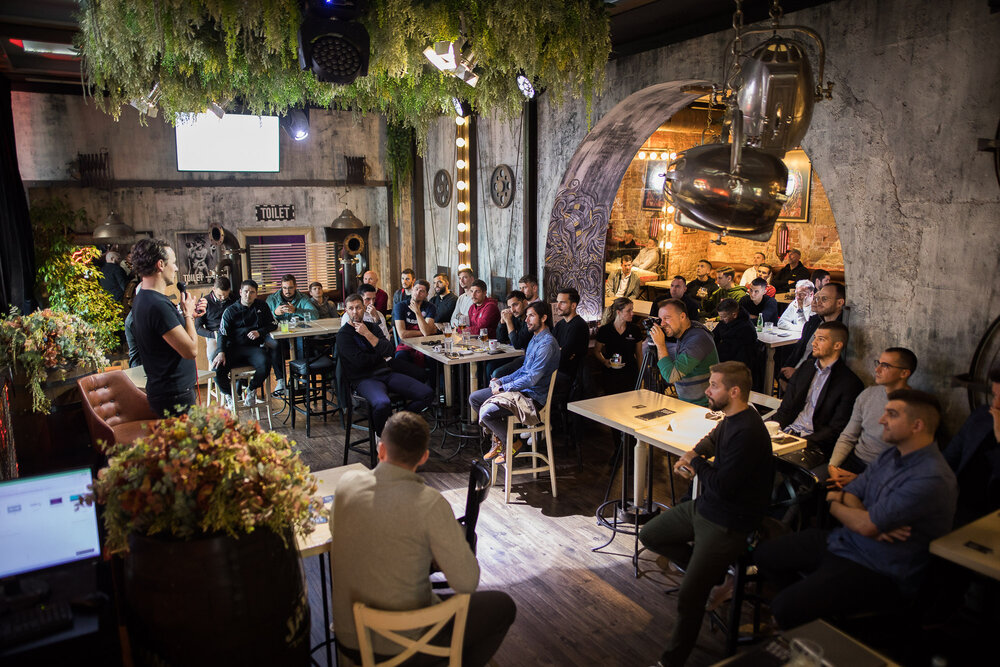
"It is a great honor to be here today to present my work at Dundee United. I have often used Croatia in my analyzes and comparisons because it is fascinating that such a small country has great success in the world and European competitions and is always at the top. I am also glad that I had the opportunity to watch the pioneers and cadets of Hajduk and see firsthand the potential and quality of young players that this area offers," said Goldie at the beginning of his presentation.
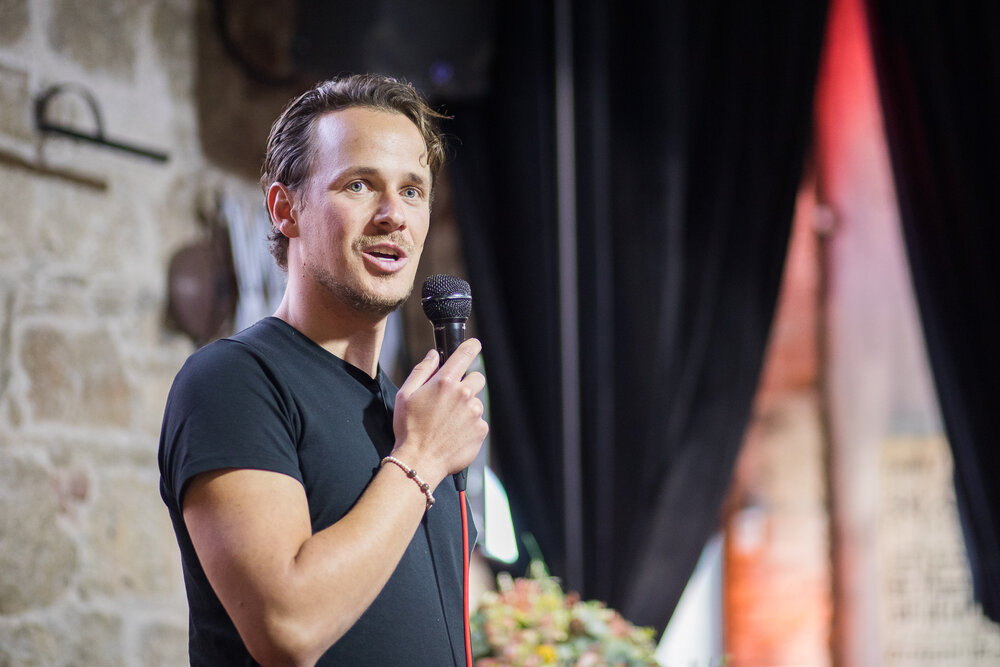
The Meetup was opened by Andro Fistonić, the man responsible for launching the new City of Football community.
"The idea was to start with informal events where we talk about football in a relaxed atmosphere. Meetups are quite normal in other industries, especially in the IT sector. What excited me is how they push each other forward, encourage knowledge sharing, and ultimately encourage people to stay in this region. The idea is to gather people who want to know more about football, from coaches, parents, managers, and investors. Through this Football Meetup, they can encourage and improve football development in Dalmatia," Fistonić said.
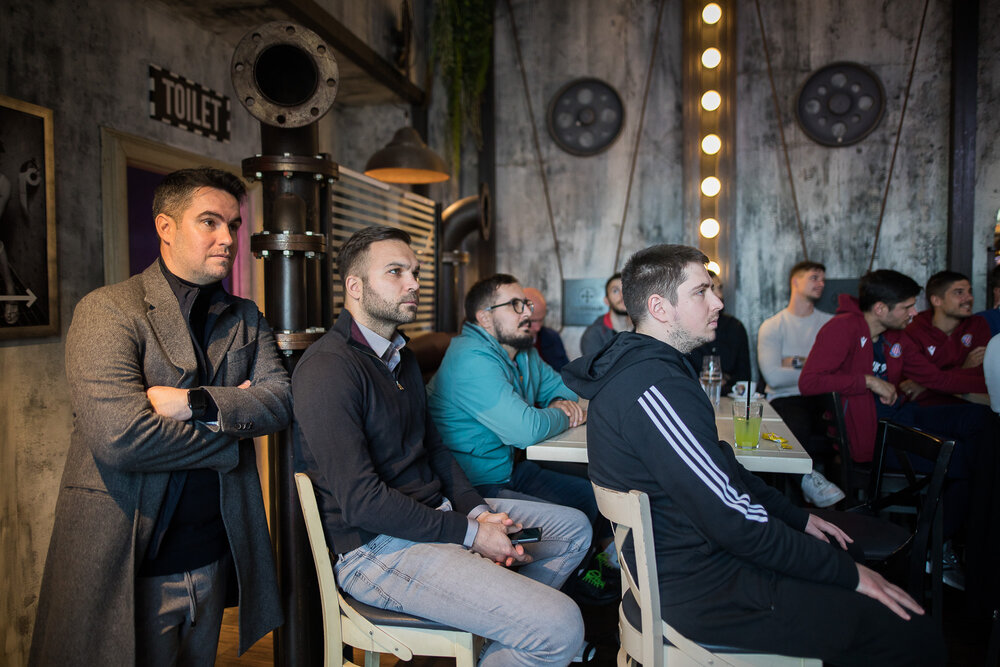
Andy Goldie presented the results of three years of work at Dundee United's Academy. He explained how with a clear strategy and plan, he raised the budget from 60,000 GBP and one employee to 400,000 GBP and fulfilled the goals of development and return on investment.
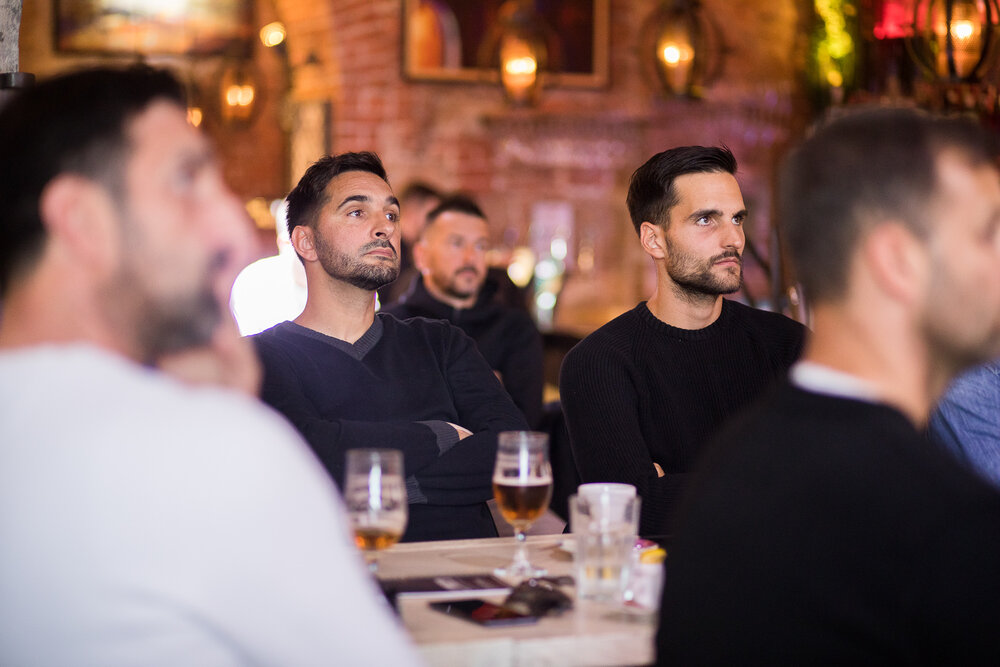
TCN caught up with Andy after the event to hear his thoughts about kicking off City of Football:
"When Andro presented the opportunity and explained the program and its future, I was excited. I think it can significantly impact this region, not only on the professional side of the game but also on the recreational and business side. It will help to build that connection and understanding and, ultimately, a more strategic direction.
This is my second visit to Split. I fell in love with it when I first visited and still love it. I love how it mixes modern and traditional. It feels authentic - nothing is commercialized here."
And his thoughts on Hajduk this season?
"Hajduk has had a period of struggle and had to refind who they are. It appears that they have refound their identity. They understand the process it takes to succeed, and it looks like they're getting that back. In football, anything is possible. Given my strong connection to Hajduk, I bought my two sons Hajduk tops to bring back home. We will definitely be supporting Hajduk."

After the presentation, there was a Q&A with Andy, followed by networking among the attendees.
"The general impression is very positive. The pub area was full, and the Q & A lasted about 30 minutes, meaning the attendees were confident to discuss and connect with the topic and speaker. The attendees included primarily coaches, but there were also agents, parents, futsal and football players, and some potential football investors. The versatile audience improved the discussion with different perspectives on the given topic," Fistonić said.
So, what's next for City of Football?
"The next Meetup will be in about two months. The idea is to continue bringing people who proved themselves internationally. For example, in the next Meetup, you can expect to see local football workers building something extraordinary in Dalmatia or Croatia. Things that you don't hear about in the media," concluded Fistonić.
The next Meetup is scheduled for early February.
All photos by Duje Bonačić
To follow the latest sports news in Croatia, follow TCN's dedicated page.
Vukovar 2022 Remembrance Day: Visitors are Gone, the City Remains
November 21, 2022 – Wherever you find yourself around the 18th of November, Vukovar will be with you. Whether you like it or not, the name will follow you like a shadow; it will keep calling you, whispering, "Think about me." This year’s day has passed. The visitors have all gone, and the city once again remains. It is time for the first TCN Vukovar 2022 Remembrance Day reflections through the eyes of a resident. Big ask. As a tourist guide here and someone who has written about the city many times before, thinking about what to say to contribute to the discussion in a valuable way is a daunting little task. No words would be enough, yet it feels like four are all we need: We are still here.
1991 – 2022. It has been 31 years. It sounds like a long time, but it feels like time has stood still on the day. Something feels different with every year that passes by, but something is always the same. It’s hard to name it; I can’t put my finger on it. It happens if you live here. You learn something every time you meet someone new. New information, new emotions, new reasons to laugh or cry. But you connect in the old way. And there are two sides to that – the lessons are hard, but they force you to grow. Like Vukovar has been growing. With and without the parade. With and without politics. During November and the remaining eleven months.
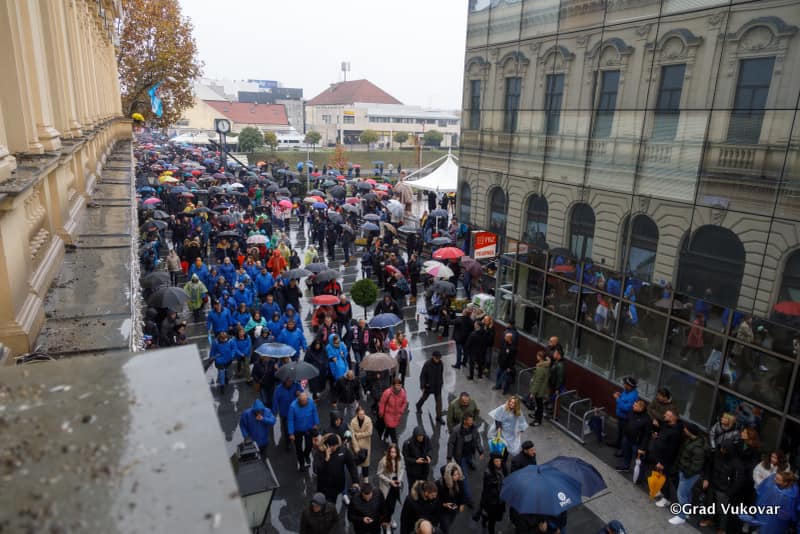
18 November 2022 (Photo by Grad Vukovar 2022)
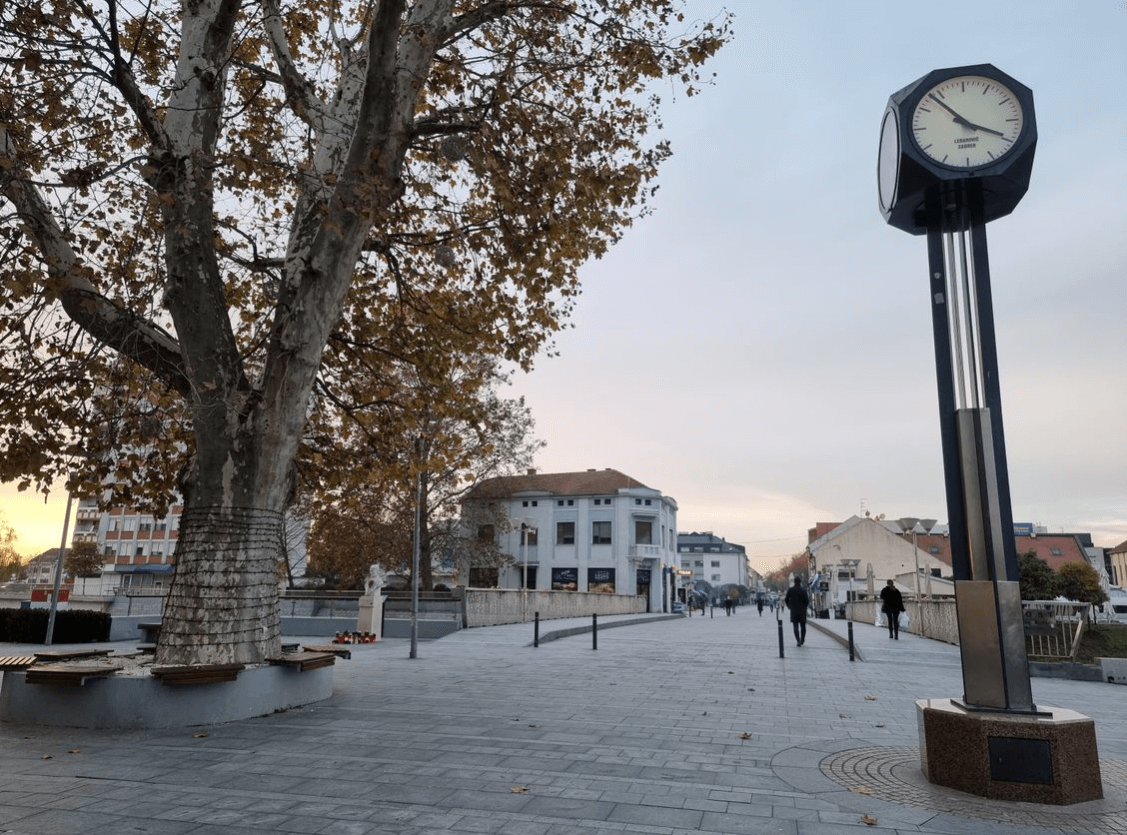
Jean-Michel Nicolier bridge (Vukovar 2022)
If you ask anyone from Vukovar to talk about it in November, they are likely to do at least one of the following things: politely ask you to move on and talk to someone else, tell their family’s story, or ask where you’ve been by now. These are some of the ways people deal with what happened here and what the reality is now.
Some don’t want to or can’t talk about it. Shake their hand and move along.
Some find it easier to tell their stories; they need compassion, appreciation, and a thank you for your sacrifice. They will open their homes and their hearts to you. Sit down with them, let them make you a cup of coffee, and listen. Cry with them, laugh with them. At times feel overwhelmed. And if they say they don’t expect you to understand, don’t believe them. Of course, you should understand. It’s not that complicated; what happened here. The human experience was reduced to its lowest form. Houses were burned, families broken apart, and lives ruined on all sides of the flag. Keep that in mind, and be respectful. Walk the parade, light a candle, and say a prayer. Remember that the whole point is to thank those who gave their lives for you to walk free and never allow that to happen again.
On the other hand, you could meet people who had nothing to do with the war, whose families were lucky, or who ended up moving to Vukovar recently. Your instinct may be to ignore them; it’s not about them. Don’t. Listen to them carefully. They live here now by choice or by fate. The city is theirs, and the city is them just as much as it is you who visits, who remembers, and talks about it.
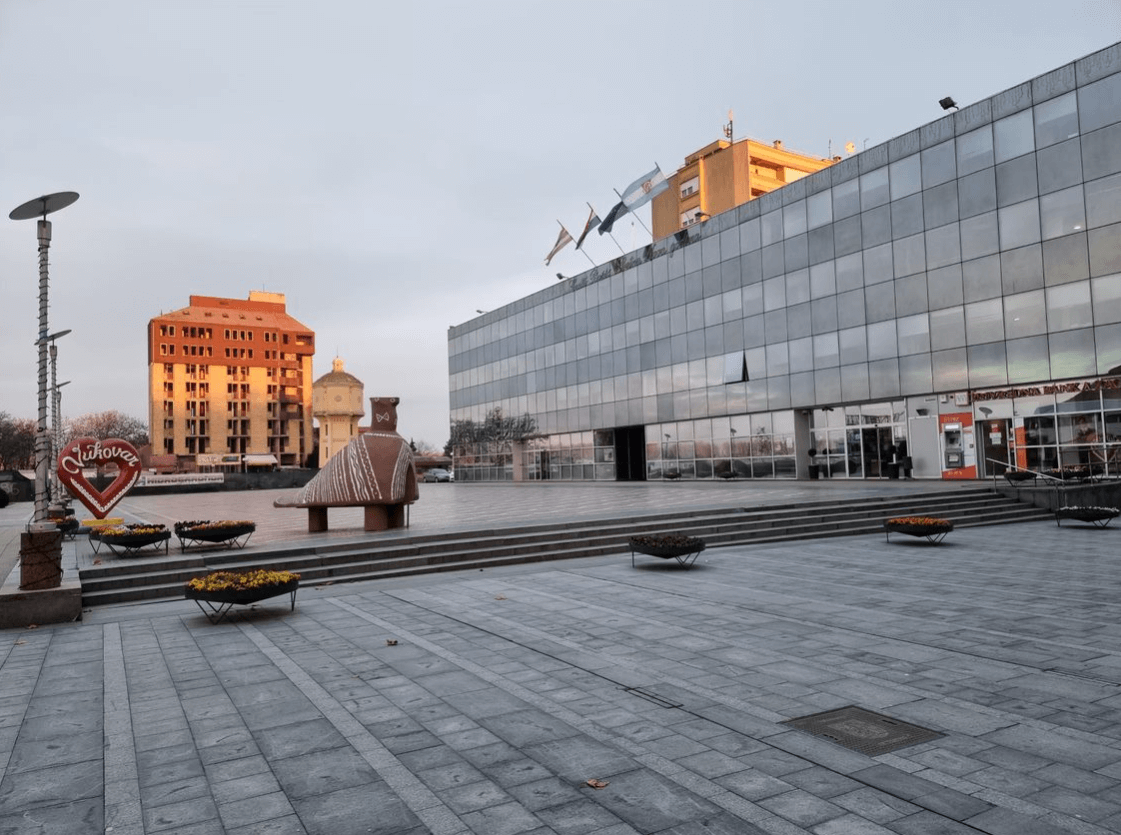
City centre Vukovar 2022 (21 November)
That brings us to the message I would like to send this year. The message that rings painfully accurate whenever we hear our co-residents say it to the cameras pointed at them in November. Come to Vukovar on the 18th, do the thing and take the pictures. We appreciate it; we really do. Without your support, we wouldn’t even be where we are today.
But don’t let that be your only visit. Do not reduce our city to pain, our streets to the parade. Recognise the artisan shops under the baroque vaults, the business that blooms daily. Sit down for a hearty meal and chase it down with a cold Vukovarsko brewed right here. Wear the Borovo shoes, which still promise and provide quality. Check out the municipal museum or hop over to Vučedol to go on a journey of five thousand years. Come and see July and August – take it easy swimming in the Danube, or get your culture fix at the Vukovar Film Festival. Run, walk, or cycle kilometres of routes through plains and forests. Try fishing for dinner.

Like in many other places in Slavonia, life is hard in Vukovar. Many leave in search of a somewhat normal life. Not because they want to but because they have to. They will come back, though, because enough of Vukovar’s driving force is still here. Those who stay and those who come to Vukovar refuse to live in the bubble of the 18th and have decided to give Vukovar what it needs and what it deserves. Love, laughter, optimism, and friendship – every day. Never forget its sacrifice, and never stop talking about it. But never ignore its future and never underestimate the willpower of its children.
For more, make sure to check out our dedicated Travel section.
Istrian Ox (Boškarin) Meat Name Protected by EU
November 21, 2022 - The joint Croatian and Slovenian action led to the Istrian ox, Boškarin, getting protected by the EU.
The Croatian media report today how the meat from a traditional breed of cattle originating from Istria, Boškarin, secured a type of EU protection. Its name was entered 'in the register of protected designations of origin and protected geographical indications (‘Meso istarskog goveda – boškarina/Meso istrskega goveda – boškarina’ (PDO))'. It is the third product placed on that register jointly, by Croatia and Slovenia, after the Istrian pršut and Istrian olive oil were already protected. Istrian sheep cheese and Istrian honey are currently in the administrative stages of the same protection.
The Boškarin meat is fresh, aged for at least 15 days in a controlled environment, from the cattle calved within the Istrian peninsula (within the borders of the Istria County, certain parts of the Primorje-Gorski Kotar County and within the Slovenian Istria).
Boškarin is an ancient cattle breed that was on the brink of extinction at one point. In the 1960s, during the breed's heyday, there were over 60,000 specimens in Istria, but numerous factors led to the decline of the population. In the early 1990s, there were only a few purebred specimens in the Croatian part of Istria, and none in the Slovenian region. Then an association of their breeders was established, and their hard work led to a sharp increase in population, and there are almost 400 cows and bulls in Istria. Boškarin meat is considered a delicacy, and something you should really seek out when in Istria.
Bolt Withdraws e-Scooters from Varaždin Streets
November 21, 2022 - After a brief period when they were available to the citizens of Varaždin, Bolt's electric scooters will soon be withdrawn from the streets.
Europe's leading on-demand transportation platform - Bolt Electric Scooters has informed the town of Varaždin that it is withdrawing e-scooters from the streets of Varaždin. Recent amendments to the Law on Road Traffic Safety stipulate the mandatory wearing of helmets for all scooter drivers, which greatly changes the way the scooter rental service is carried out, as well as their use in traffic. "Unfortunately, due to the new global situation and economic circumstances in terms of costs, as well as the upcoming winter period, the company Bolt is forced to suspend the service of renting e-scooters in Varaždin. We hope that in the near future we will have the opportunity again, in cooperation with you, to consider the re-introduction of Bolt e-scooters on the streets of Varaždin - the notice sent to the town states, thanking the administration for their support in the "successful implementation of the pilot project".
The Mayor of Varaždin, Neven Bosilj told Večernji list that he believed that the citizens got used to Bolt e-scooters and that they found them quite practical to use. However, he added, it is obvious that the new law and the mandatory wearing of a helmet require some necessary changes to how the project is to be executed. This certainly brings additional costs to the Bolt company and the profitability becomes questionable for them. However, he believes that the safety of the citizens using the e-scooters must be everyone's number one priority, and without the use of a helmet, that segment cannot be satisfied.
Exploring Croatian - A Brief History of the Istro-Venetian Language
November the 21st, 2022 - Delving further into the intricacies of the Croatian language, and veering away from standard Croatian as we know it today, let's look at another lesser spoken tongue - Istro-Venetian language.
We've looked into the main three dialects that make up modern standard Croatian as we know it today - Shtokavian, Chakavian and Kajkavian (as well as Northwestern Kajkavian), as well as some old and almost forgotten Dalmatian words, the Dubrovnik subdialect (Ragusan), and some dialects and languages which are so sparsely spoken today that they barely exist anymore. These include the Istriot language from parts of the Istrian peninsula, and of course Zaratin, once widely spoken in the Zadar area. All this clearly tells us that the Croatian language goes far beyond what most people know it as, and it has a history that is as varied as it is deep.
So, what about the mysterious Istro-Venetian language? The name might give it away, especially if you're familiar with the somewhat complicated history between Italy, Venice and the Istrian peninsula. This language which is often also called the Istrovenetic language, is heavily influenced by Venetian.
Istro-Venetian shares a common basic lexicon and language structure as other languages within the wider ''family'', but what makes the Istro-Venetian language interesting is that it is not only the most widespread (by far) of the so-called Istro-Romanic idioms still spoken today, but that it also occurs on both sides of the modern Croatian-Slovenian border. Both of these languages (the Croatian and the neighbouring Slovenian ''version'') are classified within the wider Venetian dialectal diasystem despite having a few slight differences.
If you know anything about the formerly mighty Venice and its constant expansion and extensive trade networks (you'll know a lot about this if you've ever studied the former Dubrovnik Republic), you'll know that it took not only its culture and style of architecture with it, but its language too. This was to the detriment of both Romance and Slavic languages which once reigned strong in the areas in which Venetian influence took hold. The saga is no different for the Istro-Venetian language, and its history begins with the arrival and expansion of Venetian rule across the what is the modern day Croatian Istrian peninsula.
With the ever-strengthening presence of all things Venetian across much of the Croatian coast, particularly down in Dalmatia, the Istro-Venetian language took hold and prevailed very well across urban areas, and the Republic of Venice contributed to this consolidation when it controlled most of the Istrian peninsula after around 1420.
Today, the Istro-Venetian language is primarily preserved among bilingual native Istrians, most of whom are older individuals who number approximately 25,000-30,000 people. Unlike Zaratin, which you'd be extremely unlikely to hear used at all anymore and which nosedived after the Second World War, these 30,000 people do continue to use Istro-Venetian in addition to their mother tongue.
The initial linguistic ''venetisation'' of Istria took place between the 10th and the 15th centuries, and Venetian was the official language of the administration, which is logical given the ruling body at the time. The rest of the phases rolled out with the process coming to a natural end with the end of Venetian rule in Istria in the 1800s. Despite the end of an era having occurred as far as Venice was concerned, Istrian languages (of which there are several, including Istriot) prevailed. For some lesser spoken dialects and subdialects, the passage of time unfortunately sealed their demise, but for some, such as the Istro-Venetian language, that wasn't the case.
As stated, by the 1800s, the clock had started ticking for the once mighty Venice and it weakened as a state and a ruling body in both political and economic power and influence, and a natural consequence of that came in the form of culture and language, too.
As time passed, one important linguistic period was the one which was marked by the contact of Trieste (Italy), which had gained in power and influence as a free port following Venice's weakening, and the existing Istro-Venetian language, Croatian and Slovenian languages spoken across Istria came into much deeper contact as a result. The economic expansion of that time created an extremely abundant flow of goods, people and information throughout Istria, and communication was largely dialectal. Owing to that, a relatively large part of the former Romance language continuum was restored across a lot of Western Istria. Due to the bilingualism of the original speakers of Croatian and neighbouring Slovenian, the number of speakers of what had then come to be the Istro-Venetian language gradually increased.
While nowhere near as well known as some other dialects, subdialects and languages (as some linguists and other experts argue many of them to be), the Istro-Venetian language has had a lot of efforts put into preserving it for generations of Istrians yet to come. Since back in 2012, the Festival of the Istro-Venetian Dialect (Festival dell'Istroveneto), an international cultural manifestation dedicated to the protection, evaluation and promotion of the Istrovenetic dialect, has been held in the picturesque Istrian town of Buje.
Buje is of course the ideal location for such a festival, being located in the western part of the Istrian peninsula, where the Istro-Venetian language has arguably remained the strongest, and because this hilltop town is known as the sentinel of Istria. Buje was part of the Venetian Republic from 1358 until 1797, with a high number of people identifying as Italian still living there to this very day.
For more on the Croatian language, dialects and subdialects, make sure to check out our dedicated lifestyle section.
Seasonal Workers from Third Countries Getting Scammed by Croatian Agencies
November 20, 2022 - After the summer season in Croatia, thousands of seasonal workers from the so-called third countries were left unemployed.
As Poslovni / Dnevnik report, this year alone, 105,000 work permits were issued. There are more and more workers from third-world countries like Nepal, the Philippines, and India. Agencies promised them good salaries, accommodation, meals, transportation, and visa processing, but many still had to pay hundreds of euros to come and work in Croatia.
Many were left on the road, without money, and practically in debt to slavery. What is worrying is that the Croatian institutions have almost no control over the whole situation, writes Dnevnik. The agencies through which they come often take money to get a job, and when they arrive, the salary and working conditions are nowhere near what was promised. Thus, they practically fall into debt slavery. Croatian institutions have no control over this situation nor a migration policy, but by October of this year, more than 105,000 work permits had already been issued.
Debt slavery
According to the Ministry of Labour, there are around 440 agencies that deal with temporary employment and bring foreign workers to Croatia. Another 424 natural and legal persons are involved in employment mediation.
"Let's say that they would come to work in Croatia and if you promise someone that they will have a salary of 1200, 1300 euros, then they will give that money without any problem because he thinks that in two or three months they will earn enough to cover those debts. However, it happens that they come there and work for 500 euros, and with that money, they can never pay back that debt, and they are practically forced to work for even less in the future so that they can pay back that debt and somehow survive," revealed the interviewee for Dnevnik.
The trade union says that this practice is entirely illegal.
Prostitution
Most of the workers claim that Croatian agencies took their money. To the e-mails sent to a dozen of these agencies, some more, some less politely replied that they do not take money from workers.
"I know from the stories that prostitution already appeared, and for very little money, because somehow they have to survive, they have to buy rice and food. And that's the simplest, so to say, the easiest way to make money," said one of the agency's owners.
Who knows?
The Ministry of Interior stated that they "do not maintain data collections on reports of irregularities in the labour relations of citizens of the third countries." In doing so, they issued almost 82,000 residence and work permits in 202 and nearly 106,000 in 2022 by the end of October.
What happens to these people, where they end up, and even whether the employer and temporary employment agencies that are, by the Labour Act, even at the Employment Office, they do not know.
The State Inspectorate responded to the journalist's question that they do not keep precise records of where people are from when it comes to violating the law but that they have received a large number of petitions related to violations of the law regarding the work of foreigners.
In these cases, both employers and workers who worked illegally were punished. That was about 395 citizens of third countries during this year, and the employers paid HRK 4,650,000, writes Dnevnik.
For more, make sure to check out our dedicated News section.
End of an Era: Shops to be Required to Charge for Light Plastic Bags
November 20, 2022 - End of an era in Croatia. No more free tiny little plastic bags. According to the Ministry of Economy and Sustainable Development, shops will be required to display the prices of the plastic bags used for fruit and vegetables.
As Poslovni writes, with the new ordinance on packaging, which should enter into force next year, the Ministry of Economy and Sustainable Development will introduce a return fee for packaging with a volume of less than 0.20 liters for tetrapak and which is not made of PET. At the same time, retailers will have to start charging for very light plastic bags.
The Ordinance envisages the expansion of the existing refund system with less than 0.20 liters of packaging with multi-layer (composite) packaging with a predominantly paper-cardboard component, for example, tetrapak. With plastic packaging that is not made of PET, for example, HDPE (polyethylene of high density, rigid plastic), the Ministry of Economy and Sustainable Development told Hina.
All products defined as "beverage" to enter the refund system
Regarding products in HDPE plastic packaging, the Ministry said that all products that fall under the definition of "beverage" are included in the refund system.
This concerns alcoholic and non-alcoholic drinks, table, natural mineral water, and spring water, fruit syrups, fruit juices and nectars, milk and liquid dairy products, and other liquid products based on fruit, as well as any other substance that is packaged together with the liquid base and forms a complete unit of primary packaging.
This means that oils, detergents, and other products that are not "beverages" do not enter the refund system.
Glass bottles for alcoholic and non-alcoholic drinks with a volume of 0.1 liters are included in the refund system, as well as plastic packaging with a volume of three litres or less.
The Regulation on waste management compensation and return compensation will prescribe the method of calculation and the compensation amounts. A new look for the packaging label in the return fee system is also proposed.
Very light plastic bags must be charged to consumers
The ordinance also proposes that all very lightweight plastic bags, thinner than 15 microns, used for fruit and vegetables and other bulk food, and are not currently charged in the future must be charged to consumers and that they may not be displayed and sold at cash registers.
Also, in the places where the consumer packages the goods, their price, which the seller will determine, must be displayed, according to the Ministry of Economy and Sustainable Development.
The aim of introducing a fee for lightweight plastic bags is to separate their uncontrolled free distribution and excessive collection, which often leads to the disposal of such bags in the environment.
In addition, the goal is to improve the use of thicker plastic bags, those with a wall thickness of 50 microns or more, because they end up being discarded much less often due to their greater mass and convenience for multiple uses. The ministry wants to encourage the use of bags made of alternative materials.
The Ministry says that the new rulebook is being adopted due to Croatia's obligations to transpose the provisions of the EU directives on packaging and packaging waste into the national legislation and on reducing the impact of plastic products on the environment.
The existing waste packaging management system should be harmonized with the Waste Management Act from July 2021.
Consultation on the rulebook until December 10
The rulebook was published on the Central Portal for public consultation, and the consultation is open until December 10. After that, the Ministry announced they would proceed with its final drafting.
The start of the application will be determined in the final version of the rulebook so that a period for adjustment will be set, and the Ministry will inform the public about the current application dates.
The Ordinance proposes measures to reduce the consumption of single-use plastic products, as well as measures related to the extended responsibility of producers of single-use plastic products and fishing gear containing plastic.
Measures are also proposed to raise awareness about the harmfulness of discarding plastic products and the availability of reusable alternatives.
For more, make sure to check out our dedicated News section.


